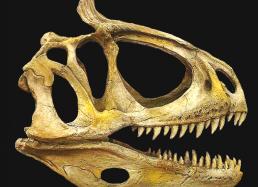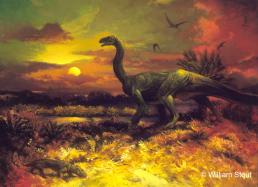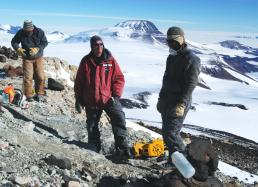About the Expedition
Much of what we know about the evolution of life on Earth is based on fossils found in the Northern Hemisphere. That's why fossils from Antarctica are so valuable—they fill in gaps in our knowledge by giving us a rare glimpse of long-ago life in southern regions.
From fossils, we now know that the ancient Antarctic environment was much more livable than today. It hosted an astonishing array of plants and animals and may even have acted as a refuge during periods of climate change.
Antarctic Dinosaurs
Previous expeditions to Antarctica uncovered two early giants from the dawn of the dinosaurs: the one-ton, long-necked, plant eater Glacialisaurus and the 25-foot-long, crested, meat eater Cryolophosaurus. These two dinosaurs appear to be unique to Antarctica, where they lived side by side along the continent's heavily forested coastline around 190 million years ago, during a much warmer period on Earth.
By studying the fossils of these animals, The Field Museum hopes to learn how dinosaurs and other species had adapted to their polar environment, and how they were affected by habitat and climate change throughout time.
The 2010-2011 Expedition
Over the holiday season of 2010-2011, Field Museum paleontologists Pete Makovicky and Nate Smith joined a combined team of scientists from Augustana College, the University of Washington, the University of Alberta, and the Iziko South African Museum to search for more fossils in the Transantarctic Mountains.
The team spent two months completing excavations at the two Early Jurassic dinosaur sites on Mt. Kirkpatrick where Cryolophosaurus and Glacialisaurus fossils were discovered and explored Early and Middle Triassic sites near the Beardmore and Shackleton Glaciers, then looked for brand new sites in unexplored areas.
The Expedition's Results
During the expedition, the team braved tremendous storms, endured illnesses, and survived the Christmas holidays away from their families to locate and excavate several exciting new fossil dinosaur and plant finds. Their efforts paid off, and these finds have now made their way back from Antarctica, where they'll be studied over the coming years by the collaborating institutions.
Ultimately, the team hopes to establish more precise dates for Antarctic fossils so that they can learn how species are related to one another worldwide, which are common or unique to Antarctica, and how they survived and recovered from mass extinctions to diversify over time.
To learn more about ancient Antarctic life and the team's fascinating fossil finds, explore the stories in "About the Expedition," and be sure to check out Pete and Nate's photo galleries, videos, and blogs from their 2010-11 expedition.




